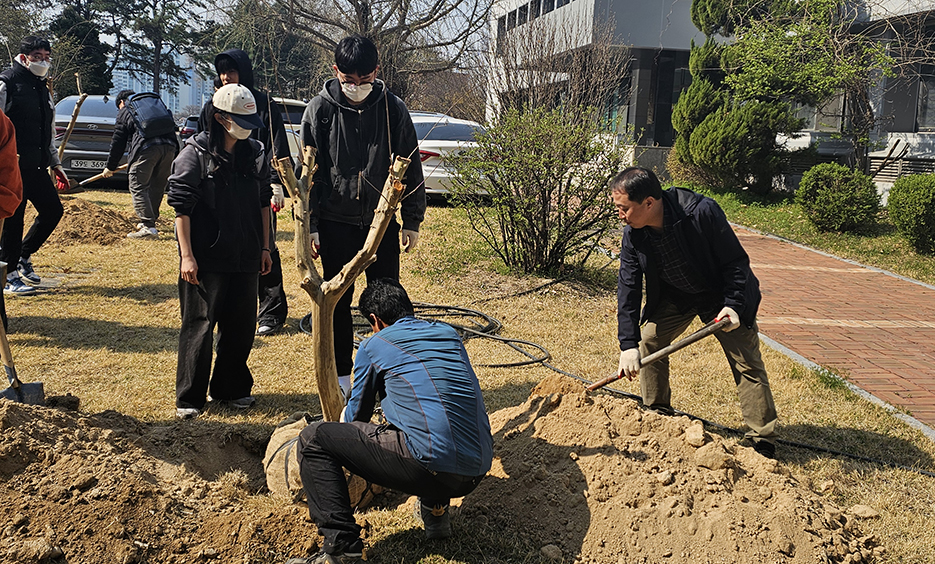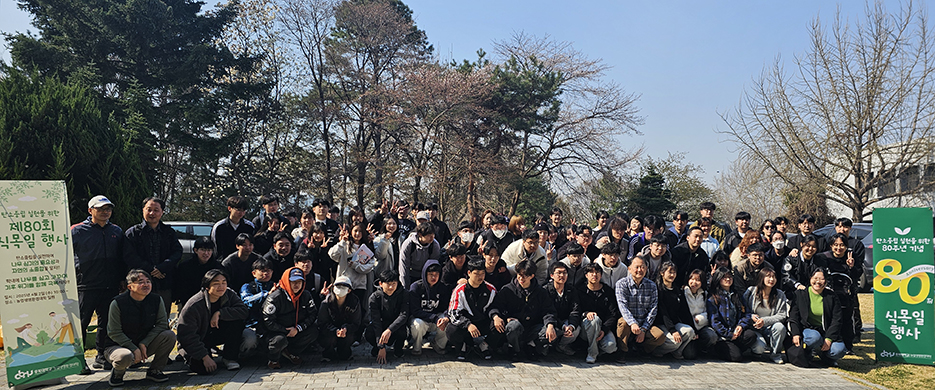The Chungbuk Times > Feature > View
Is Arbor Day Necessary?
제 221 호 발행일 : 2025.04.14
Every April 5 is Arbor Day. Arbor Day is a celebratory day that encourages planting and caring for trees. The origins of Arbor Day are diverse. One of the most notable origins is that it corresponds to Feb. 25 in 677, when the Silla Kingdom expelled the Tang Dynasty’s influence from the Korean Peninsula and completed unification. It is also the date corresponding to March 10 in 1493, when King Seong-jong of the Joseon Dynasty held a ritual at Seonnongdan-Altar (an altar outside Dongdaemun dedicated to the god of agriculture) and then personally farmed at Jeokjeon, land designated for ceremonial use where the king demonstrated agricultural practices. In Korea, the first official tree-planting event was held when the Japanese Colonial Government of Korea designated April 3 in 1911, as Arbor Day during the Japanese colonial period. However, after Korea was liberated from Japanese colonial rule, the U.S. Army Military Government in Korea designated April 5 in 1946, as Arbor Day, and this tradition has continued to the present day.

The Importance of Arbor Day
Arbor Day is fundamentally about fostering forest resources. In the early 1940s, many barren mountains were visible due to the reckless exploitation of forest resources at the time. The shortage of forest resources exacerbated flood damage. Additionally, during the Korean War, numerous forests were destroyed, and a large amount of timber was needed for post-war reconstruction, leading to the devastation of the remaining forests. In this situation, the need for the protection of forest resources grew, eventually leading to the establishment of the First Ten-Year Forest Rehabilitation Plan in the 1970s.
Creating forests provides various benefits to the environment. Notably, it improves air quality and helps create ecosystems. Air quality improvement refers to the creation of forests to mitigate fine dust pollution and the urban heat island effect, which have become recent issues. An example of forest creation for air quality improvement is the fine dust-blocking forest in Siheung-si, Gyeonggi-do. According to a study by the National Institute of Forest Science (NIFoS), an analysis of the fine dust-blocking forest in Siheung-si, Gyeonggi-do, showed that the average fine dust concentration decreased by 49.5% over a period of 17 years from 2006 to 2023. Additionally, when forests are created, forests provide a habitat for various plants and animals. It helps each species maintain balance within the ecosystem and contributes to the stable maintenance of the natural food chain.
Is Arbor Day Effective?
Every year, the government and public institutions hold various events to celebrate Arbor Day. The events, such as the Arbor Day celebratory poster contest, tree planting, and idea competition, aim to raise public awareness of Arbor Day and encourage participation. However, these various events are led by the government, and it is rare to see individuals personally celebrating Arbor Day. According to a survey by Gallup Korea, 41% of respondents stated that they have not planted a tree. The most common reasons for this were “lack of opportunity to plant a tree” (37.3%) and “difficulty in finding a suitable place to plant” (24.6%).
Korea has achieved lush forests through a successful reforestation project. According to the 2020 Korea Forest Resources Report published by NIFoS, the total forest stock in 2020 increased more than tenfold compared to 1974, and the barren mountains that were once commonly seen across the country have almost disappeared. However, tree-planting events continue to be held nationwide every year on April 5 to celebrate Arbor Day. Why do these events continue to be held despite the already abundant forests? To find out, CBT reporters conducted an interview with Professor Lee Hwa-yong of the Dept. of Forest Science at CBNU.
Q1. Has the meaning of Arbor Day changed from the past to the present?
During the Japanese colonial period and the Korean War, Korea’s forests were severely damaged due to Japan’s exploitation and the war. As a result, planting trees became a crucial task for forest restoration. Later, the government carried out reforestation projects to create the lush forests seen today. However, policies prioritized the quantity of forests over their quality. They are still making efforts to continuously manage forests and provide tangible benefits to the public. Especially as the global climate crisis intensifies, forests are gaining attention as carbon sinks. The need for Arbor Day is growing even more to manage and expand them effectively. Additionally, as urban forests play an increasingly important role in improving the quality of life for citizens, the significance of Arbor Day is being further emphasized.
Q2. Are there any cases where destroyed forests have been restored due to Arbor Day?
I am not aware of any case where destroyed forests have been directly restored due to Arbor Day. However, in the past, the Korean government designated the period from March 21 to April 20 in 1974, as the National Tree-Planting Period to encourage nationwide participation in tree planting, with even the president promoting tree planting. As a result, the First Ten-Year Forest Rehabilitation Plan, originally planned from 1973 to 1982, achieved its goal in four years ahead of schedule and was completed early.
Q3. What are the specific benefits of planting many trees?
Looking at the role of trees, we can see that properly nurturing them is important. In our daily lives, trees are used not only for furniture like desks and chairs but also as raw materials for paper products such as A4 paper, milk cartons, and newspapers. Recently, in addition to these traditional uses, the environmental roles of trees (such as carbon sequestration, fine dust reduction, and urban landscape improvement) have also been gaining attention. Trees planted in forests absorb carbon, helping to mitigate climate change, urban trees reduce fine dust, alleviate the heat island effect, and enhance the landscape, creating a more pleasant environment. As you can clearly see, trees are essential to us, and it is important to continuously plant and nurture them.
Q4. What do you think about the public’s awareness and participation in Arbor Day? If participation is low, what measures do you think are needed to improve it?
I think public awareness and participation in Arbor Day are very low. To improve awareness of Arbor Day, I believe that the efforts of those studying forestry are primarily needed. This is because forestry specialists can access information about the value of forests more quickly. If those studying forestry promote the value of forests and highlight their importance through research, the public will be able to understand the value of forests more easily. As a result, public awareness and participation in Arbor Day are expected to increase.
Q5. Recently, due to the global warming, the optimal time for tree-planting has advanced, and there is growing discussion about adjusting Arbor Day accordingly. I would like to hear your thoughts on this matter.
You are right. The optimal time for tree planting has advanced. However, even in the past, when Arbor Day was considered the optimal time for tree planting, the planting seasons differed because Korea has a long territory from north to south, so the optimal time for planting trees in Jeju-do and Gangwon-do was different. Therefore, I consider Arbor Day to be a symbolic day. I think to hold tree planting events in each region during the same period as the past National Tree-Planting Period.
Q6. Could you introduce some ways in which citizens can participate in Arbor Day activities?
The easiest way for citizens to participate in Arbor Day would be to join tree planting events organized by local governments. Additionally, although not a direct tree planting event, the prominent local environmental movement organization ʻThe Forest for Life,’ which focuses on forestry, offers training for citizen gardeners. I think participating in this training is a part of citizens’ involvement in tree planting.
Q7. Lastly, could you please share a message with the members of CBNU in relation to Arbor Day?
Recently, large forest fires occurred in areas such as Uiseong-gun and Sancheong-gun, leading to casualties. Forest fires destroy forests in a moment, and it takes a long time for a damaged forest to restore its original functions. On the campus of CBNU, numerous trees grow, delighting our eyes with green sprouts and flowers in the spring, providing cool shade in the summer, and gifting us with beautiful autumn leaves. We casually enjoy the benefits that forests provide in our daily lives. Although the value of forest is not immediately reflected in economic benefits, they play an important role in making our lives more comfortable by mitigating the climate crisis, reducing fine dust, and alleviating the urban heat island effect. Although it may be difficult to directly participate in the tree planting event on campus, I encourage you to pay more attention to the trees on campus and enjoy the valuable benefits they provide. Thank you.
The Campaign of Own My Tree
The 80th Arbor Day event this year is being held nationwide by various local governments. One of the representative events in which local governments participate is the Own My Tree campaign. This campaign, held by local governments, enterprises, and other institutions, encourages people to own a tree, raising awareness and attention to trees. The schedule and locations for the Own My Tree campaign in each region can be found on Korea Forest Service Website―Afforestation―Own My Tree Campaign.

By Park Yong-bin | 2021014006@chungbuk.ac.kr
By Park Min-a | pmina0124@chungbuk.ac.kr